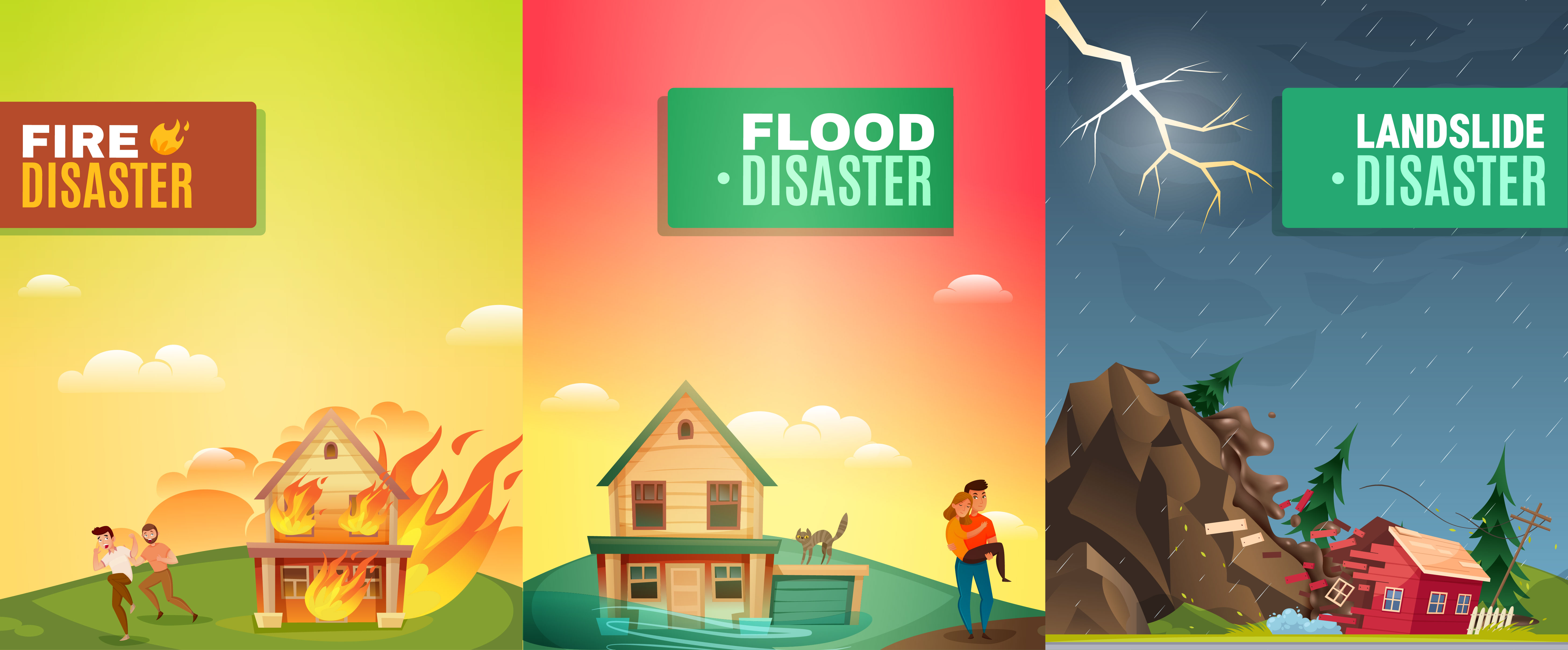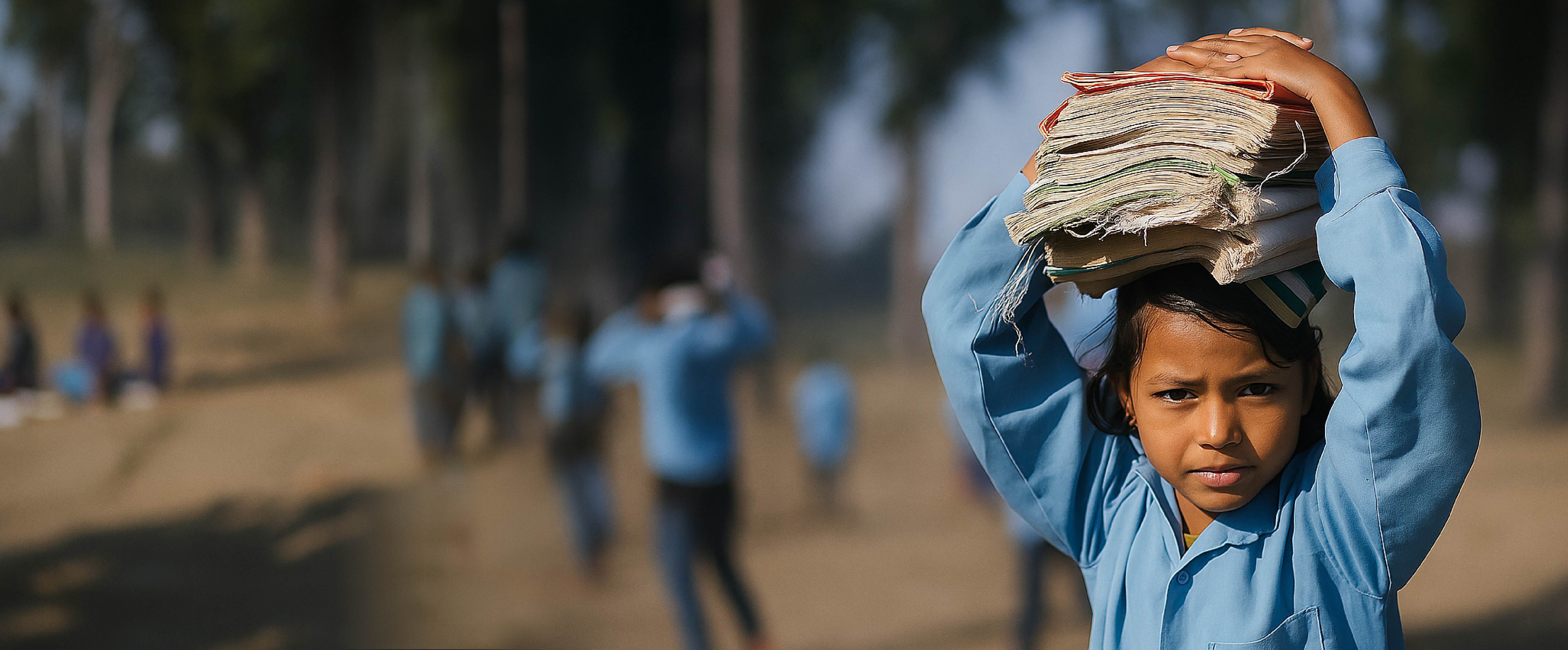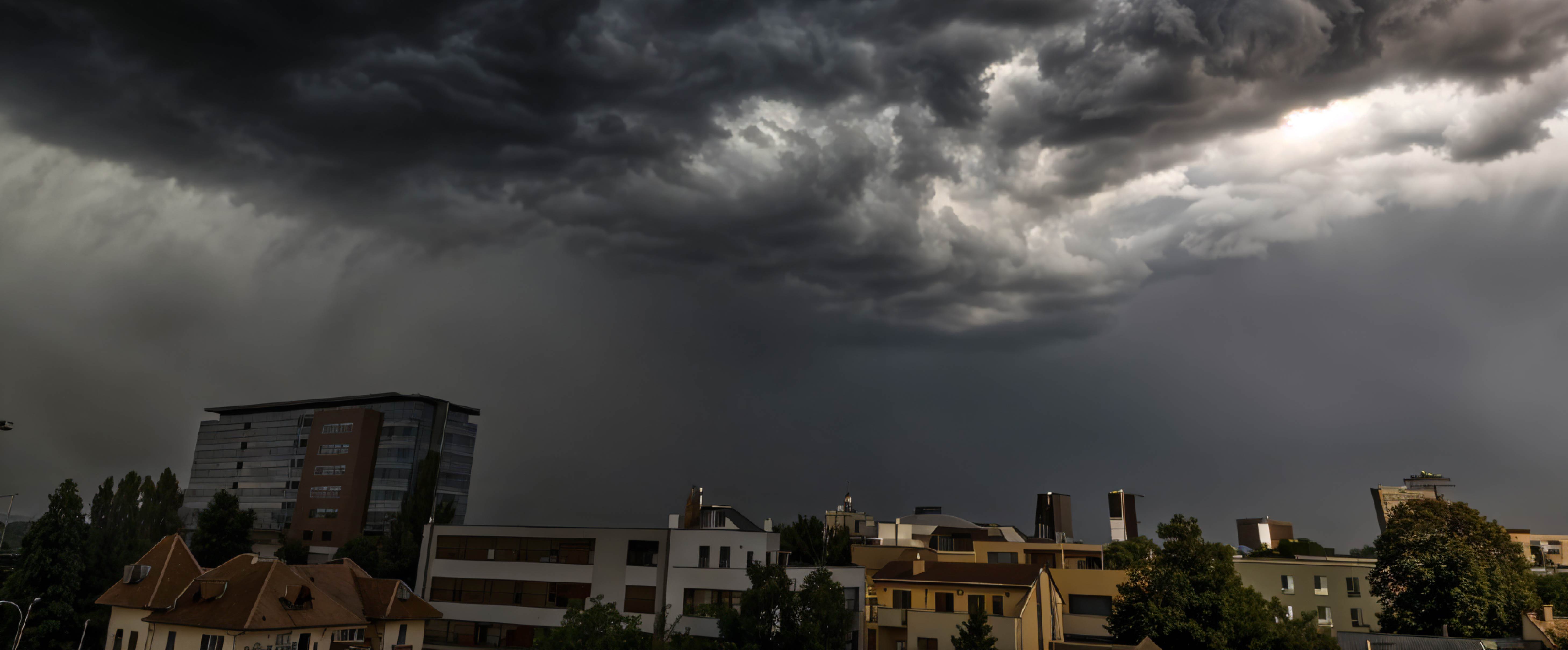Introduction
While natural forces trigger disasters, their devastation in Nepal often results from human actions, unplanned development, environmental degradation, and insufficient preparedness. Nepal is particularly vulnerable due to its mountainous terrain, fragile ecosystems, and limited infrastructure, increasing its susceptibility to disasters like earthquakes, fire, landslides, and floods.
Between January 2016 and April 2025, Nepal recorded nearly 50,000 disaster incidents according to data from the Disaster Risk Reduction Portal. Fire-related disasters (structure fires and wildfires) constituted the majority, around two-thirds of all reported cases. This high frequency is linked to rising temperatures, prolonged dry spells, and climate change making vegetation more susceptible to ignition. Other common disasters included landslides, thunderbolts, heavy rainfall, animal encounters, and floods.
The human impact has been significant. In the same period (2016-April 2025), disasters affected nearly two lakh families, caused over 5,000 deaths, injured more than 15,000 people, and left hundreds missing. Although fires were the most frequent, they accounted for about 16% of total deaths and nearly a quarter of injuries. Landslides were the deadliest, contributing to nearly 31% of all fatalities and almost half of the missing cases. Earthquakes, though less common, affected the largest proportion of families (about 33%). Floods affected around 17% of families and accounted for 46% of missing persons.
Economically, the losses have also been substantial, estimated at over NPR 33 billion during this timeframe. Fire disasters were the most economically devastating, responsible for nearly 75% of total losses, reflecting their frequency and the extent of property damage. Floods and earthquakes each contributed around 8% of total losses, while landslides accounted for roughly 6%.
This persistent destruction necessitates a shift in Nepal’s disaster management approach from reactive response to proactive strategies focusing on preparedness, mitigation, and resilience-building. Given the significant human and economic toll from fire, landslides, and floods, understanding their characteristics, fatalities, financial impacts, seasonal variations, and management strategies is crucial.
Legal and Policy Framework
Nepal has developed a legal framework for disaster risk management, including the Disaster Risk Reduction and Management Act, 2017, Rules, 2019, National Policy, 2018, and Strategic Plan of Action (2018–2030). The Constitution of Nepal assigns disaster management responsibilities to all three tiers of government. However, this framework is largely general rather than disaster-specific. While some specific issues are addressed (e.g., forest fires under the National Forest Fire Management Strategy, 2010 and Forest Act, 2019; heat waves under a 2024 plan of action; landslides under relocation procedures; floods under Water Induced Disaster Management Policy, 2015 and a 2024 monsoon action plan), these specific frameworks are fragmented and often weakly enforced. The dominance of general laws over specific, enforceable policies is identified as a critical reason for Nepal's continued vulnerability. A lack of detailed technical standards, disaster-specific preparedness measures, and enforcement mechanisms undermines risk reduction efforts, especially with escalating impacts from climate change, urbanization, and environmental degradation.
Annual Occurrence
Figure 1: Number of fire, landslide and flood occurrence from 2016 to April,2025

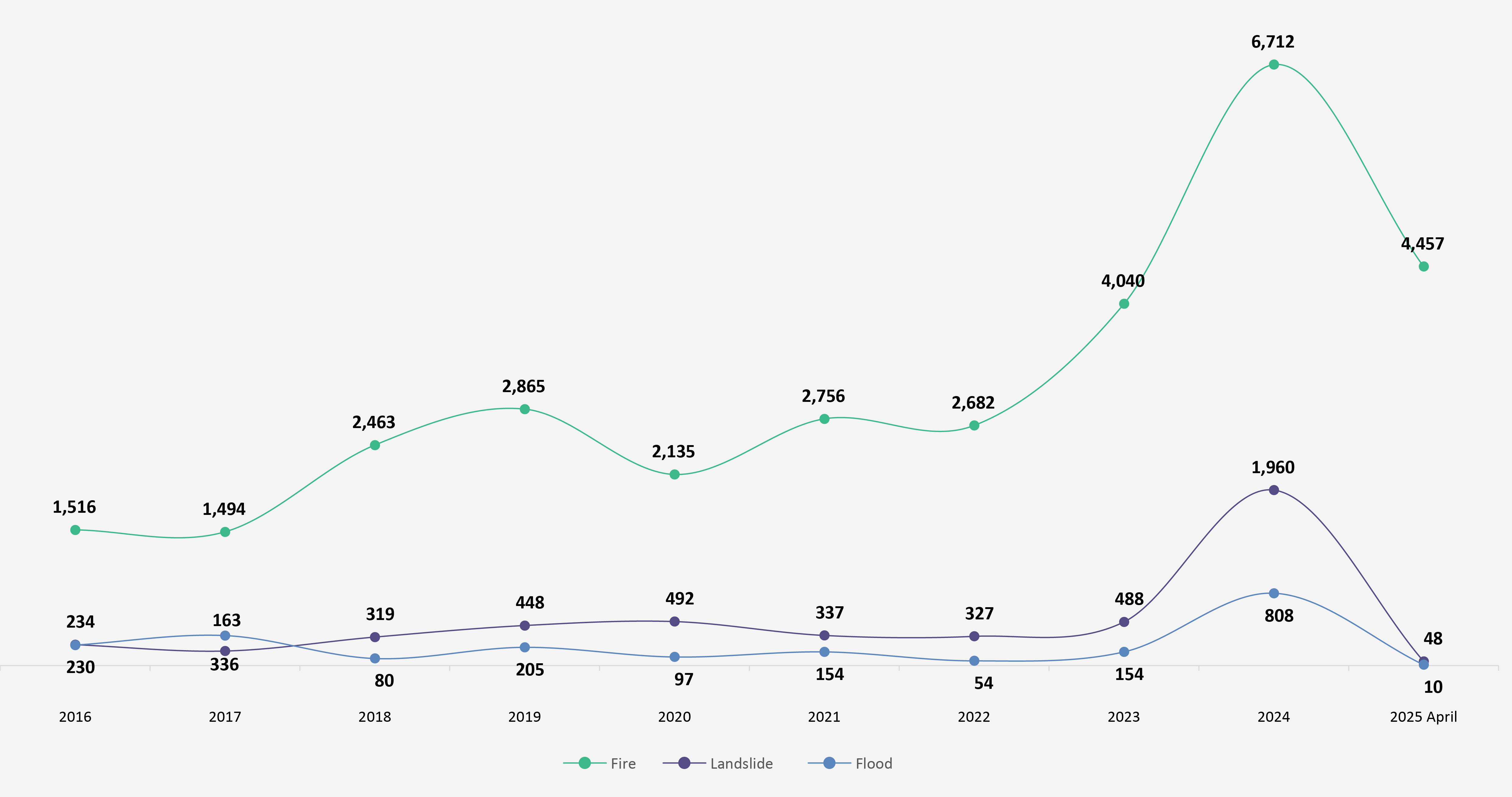 Source: Disaster Risk Reduction Portal
Source: Disaster Risk Reduction Portal
- Fire incidents increased sharply from 2023 to 2024, linked to dry conditions, climate change, and potentially insufficient prevention. Fire incidents remained relatively high in the first four months of 2025, continuing the 2024 trend.
- Landslide occurrences surged dramatically in 2024, possibly due to intense rainfall and gaps in mitigation.
- Flood incidents also rose sharply in 2024, suggesting extreme weather and inadequate flood management systems played a role.
Based on the analysis up to April 2025, it is likely that the disaster impact in 2025 could exceed that of 2024.
Annual Deaths
Figure 2: Number of death by fire, flood and landslide from 2020 to 2024
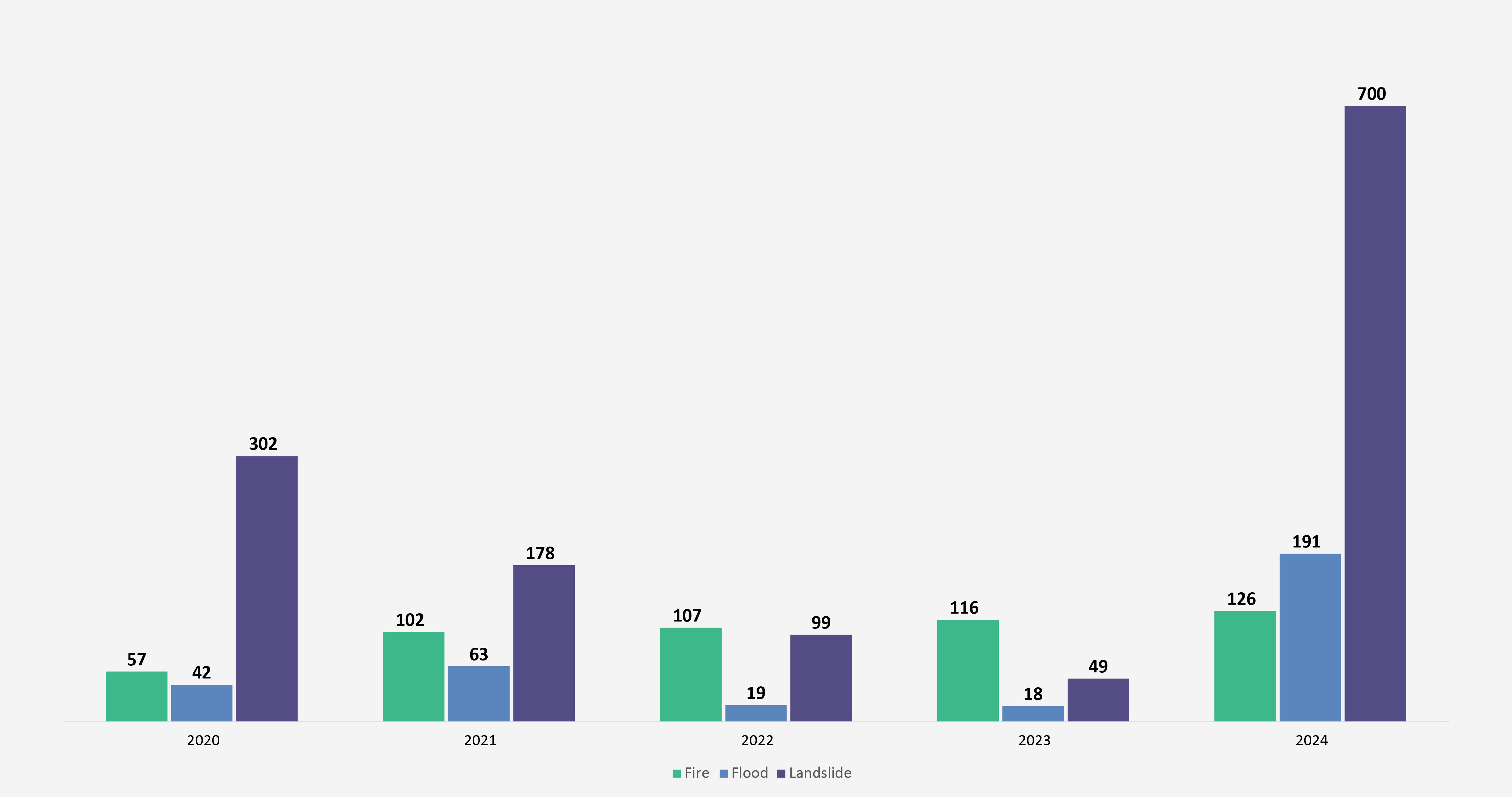 Source: Disaster Risk Reduction Portal
Source: Disaster Risk Reduction Portal
The causes of disaster-related deaths have shifted from 2020 to 2024.
- Landslide fatalities have generally been higher than those from floods or fires, except in 2022 and 2023.
- Fire-related deaths increased up to 2023 but declined in 2024. This occurred despite 2024 having the highest number of fire incidents and financial losses from fire, suggesting fires cause relatively greater economic damage than human casualties currently.
- The year 2024 saw a sharp resurgence in deaths related to landslides and floods, raising concerns about the durability of previous disaster management gains and pointing to new or intensified risk factors.
Annual Estimated Loss
Figure 3: Estimated loss (Rs.in millions) by fire, flood and landslide from 2020 to 2024
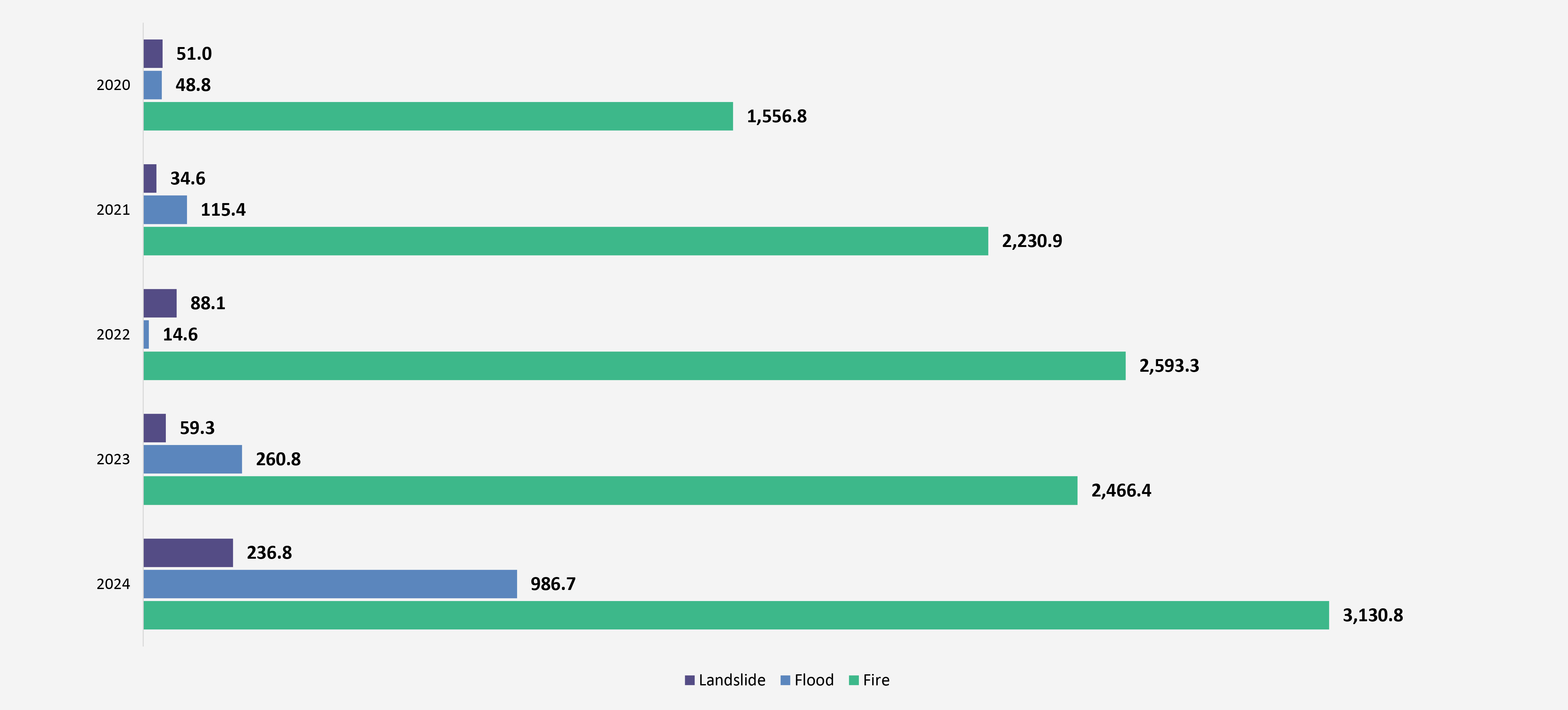 Source: Disaster Risk Reduction Portal
Source: Disaster Risk Reduction Portal
Financial losses reveal distinct trends from 2020 to 2024.
- Fire consistently caused the highest estimated losses, with a steady increase peaking sharply in 2024. This suggests growing risks from urbanization, climate change, or inadequate prevention.
- Flood-related losses, initially low, surged dramatically in 2024, indicating an unusually severe event or gaps in management.
- Losses from landslides were comparatively lower and more stable, though also rose noticeably in 2024. The simultaneous spike in financial losses across all three disaster types in 2024 highlights the urgent need for enhanced risk reduction strategies to prevent a recurrence or worsening in 2025.
Seasonal Distribution
Figure 4: Average number of fire, landslide and flood occurrence by season
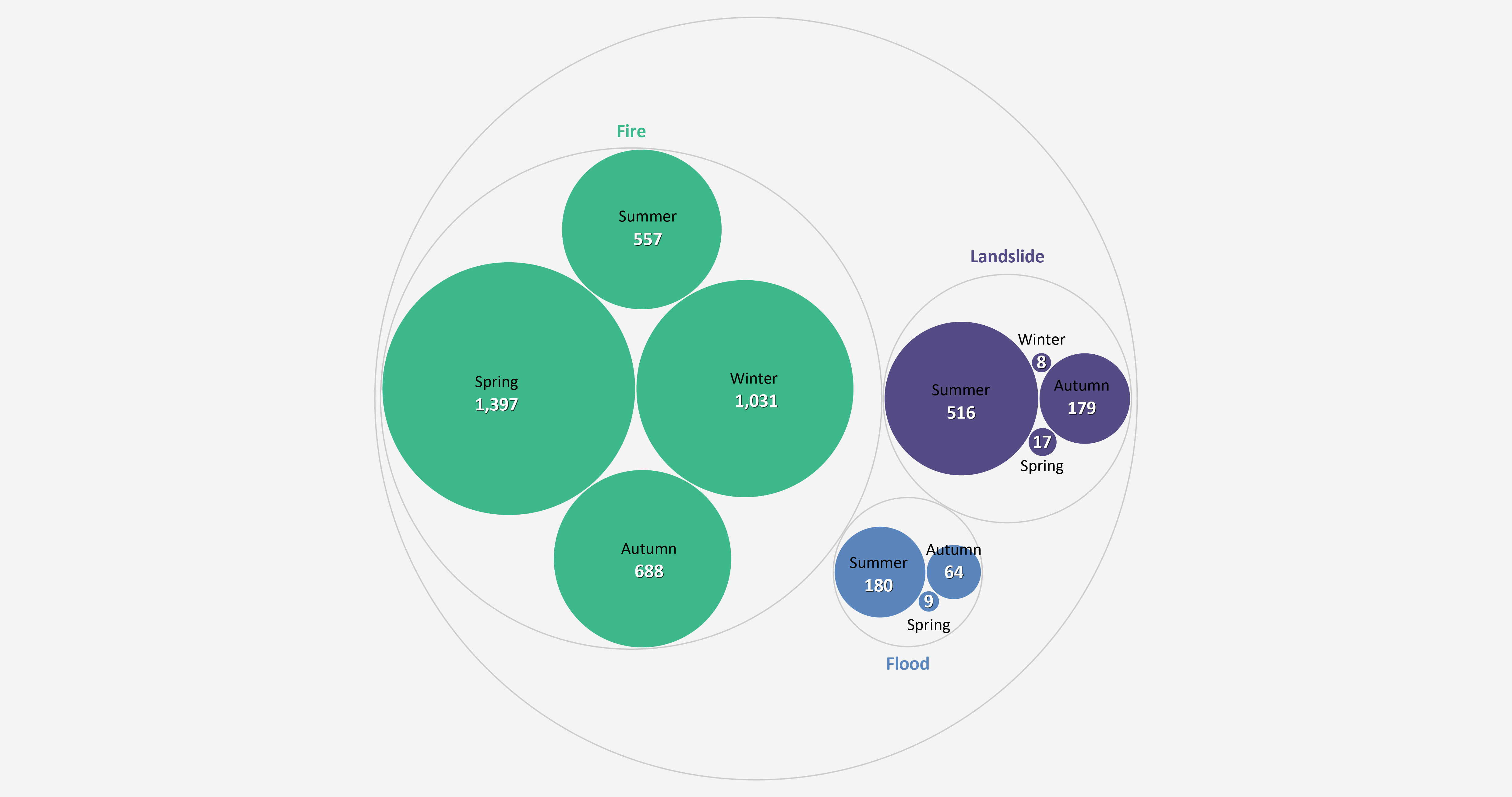
Disaster incidents in Nepal show distinct seasonal patterns from 2020 to 2024. Seasons are classified as Spring (March-May), Summer (June-Aug), Autumn (Sept-Nov), and Winter (Dec-Feb).
- Fire incidents are highest in Spring and Winter. This is attributed to dry weather, strong winds, and agricultural practices like open burning, creating conditions conducive to fires. Based on observations up to April 2025, fire occurrences are expected to continue rising through April and May, potentially exceeding 2024 levels.
- Landslides and floods are most prevalent during the Summer monsoon season. Intense rainfall saturates soil, destabilizes slopes, and causes rivers to overflow. Heavy rainfall in 2024 particularly exacerbated these disasters. While landslide and flood incidence was low in the first four months of 2025, a sharp increase is anticipated with the onset of summer, warranting heightened preparedness.
Geographic Concentration of incidents
Figure 5: Average number of fire incident in district by season
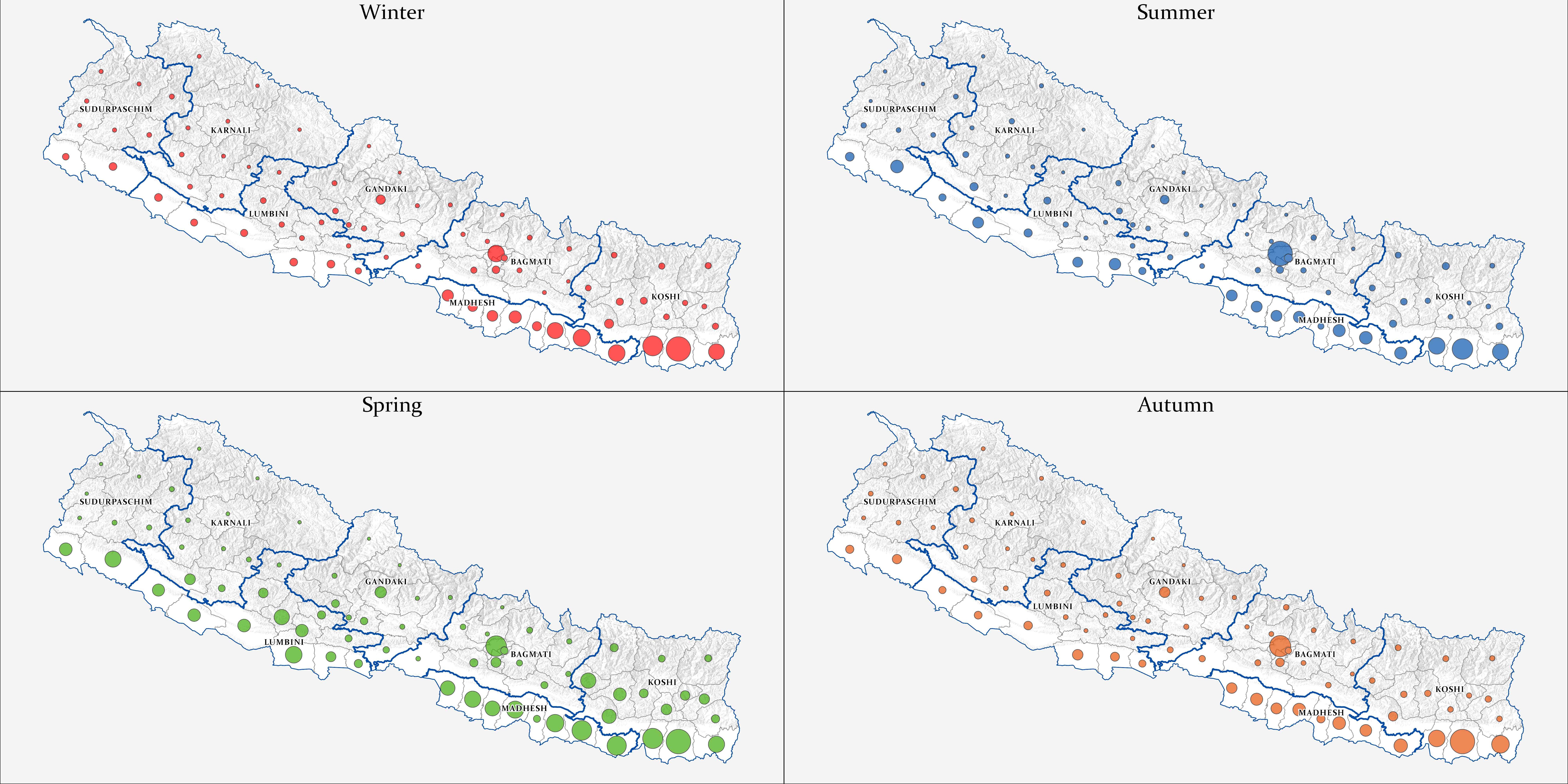
Kathmandu, Morang, and Saptari were top fire affected districts from year 2016 to 2020. After 2020, Morang, Kathmandu, Sunsari, Jhapa, and Saptari rank highest. Within Kathmandu, Kathmandu Metropolitan City consistently reports the most structural fires, increasing annually. Forest fires in Kathmandu show a different trend; Dakshinkali Municipality went from no incidents in 2020 to the highest number by 2024.
Figure 6: Average number of landslide incident in district by season
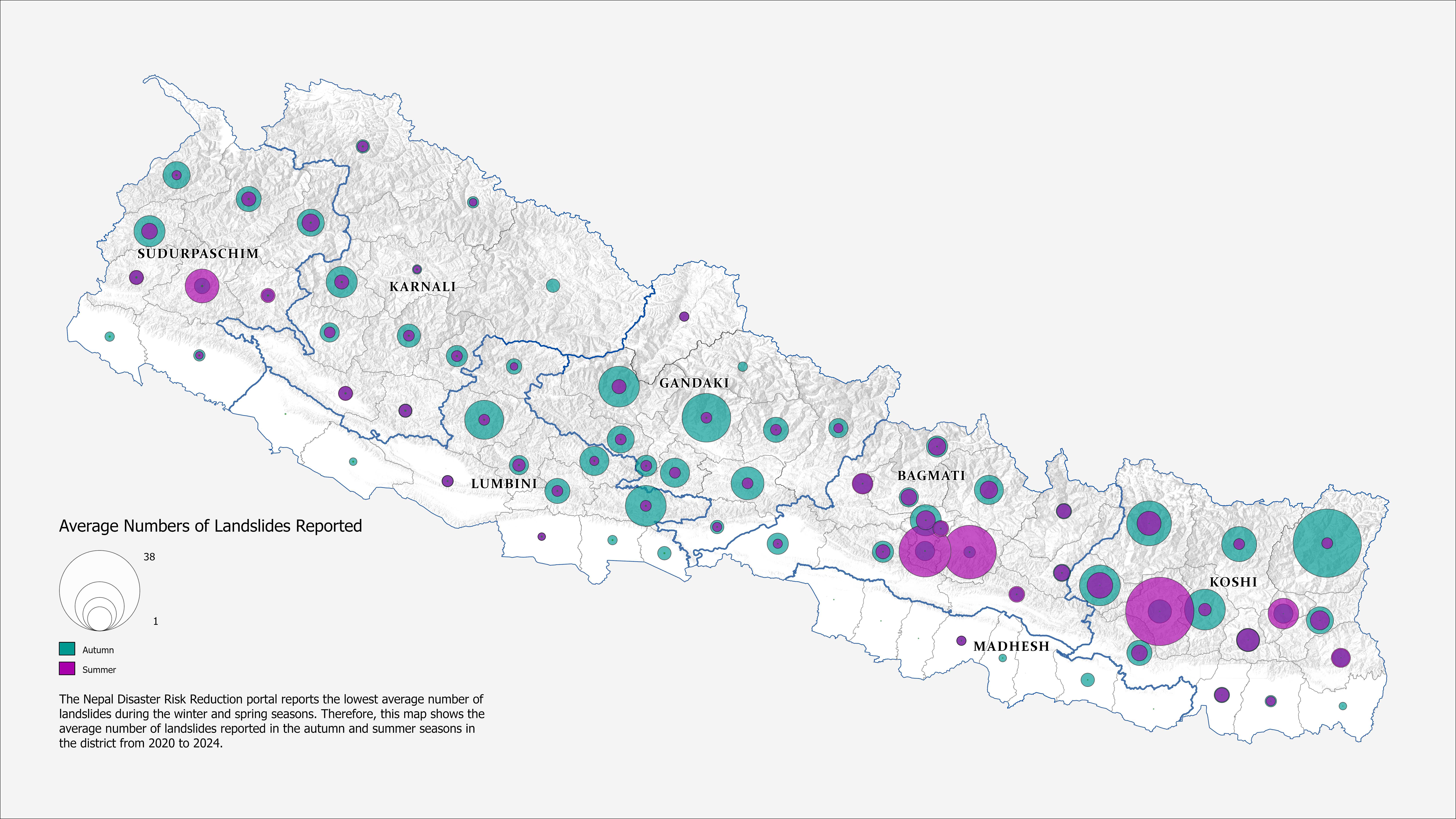
Sankhuwasabha, Baglung, and Bhojpur were most affected districts from 2016 to 2020. After 2020, Khotang, Lalitpur, Taplejung, Kavrepalanchok, and Solukhumbu report the highest incidence. Within Khotang, Diktel Rupakot Majhuwagadhi Municipality had the most landslides, with a spike in 2024 linked to heavy rainfall and construction. In Solukhumbu, Solududhkunda Municipality also reports high frequency, correlating with heavy rainfall.
Figure 7: Average number of flood incident in district by season
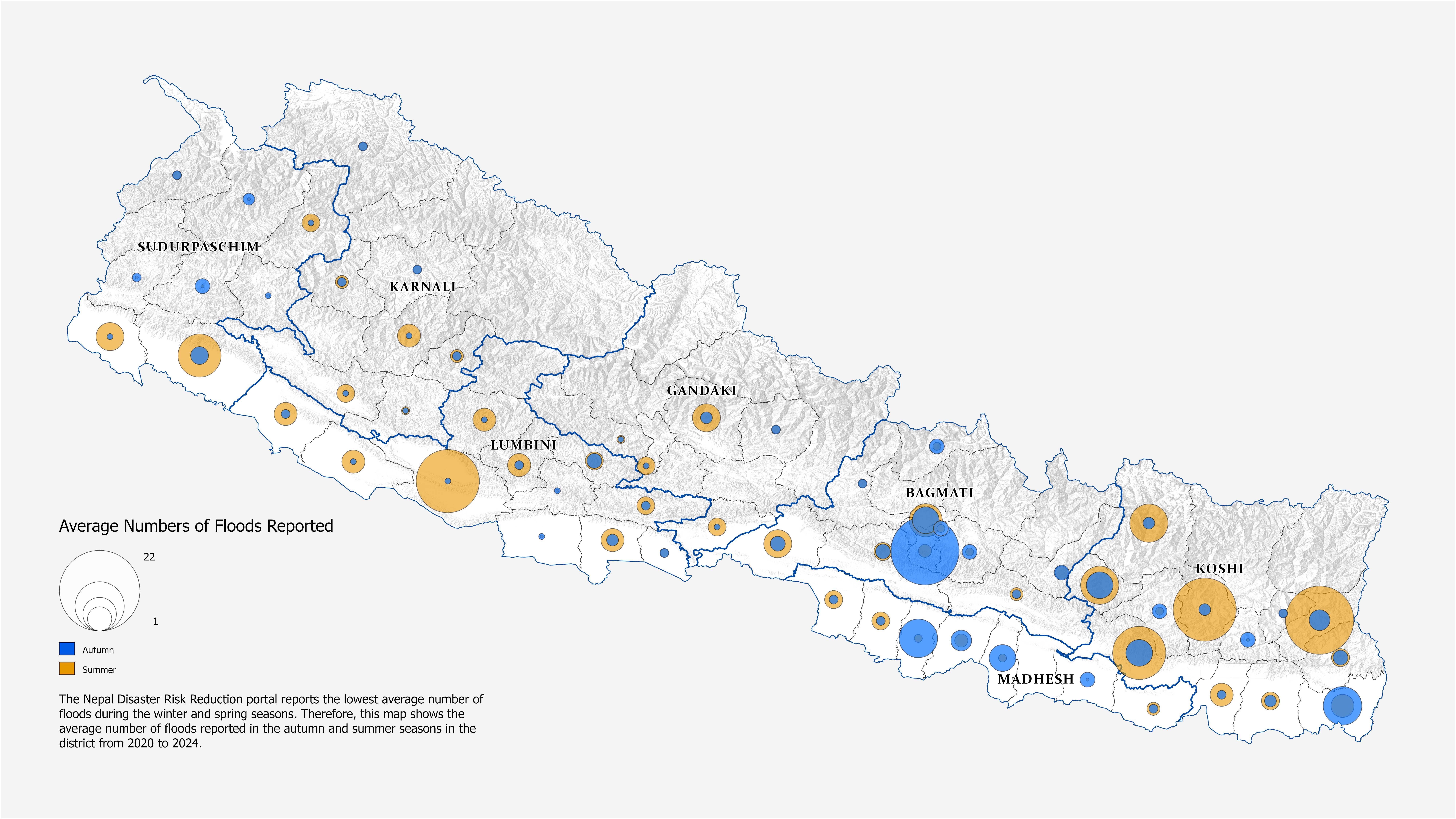
Morang, Jhapa, and Sunsari recorded the highest numbers incidents from 2016 to 2020. After 2020, while Jhapa remains vulnerable, new critical zones include Lalitpur, Udayapur, Panchthar, and Sankhuwasabha. Lalitpur district, specifically Mahalaxmi Municipality and Godawari municipality, has experienced significant flood impacts. A strong correlation exists between heavy rainfall, flooding, and landslides, particularly evident in Lalitpur Metropolitan City where increases in all three have been observed.
Summing up
The analysis underscores a critical gap in effective disaster risk management due to continued reliance on general legislation despite rising disaster impacts. Given the distinct characteristics of fires, landslides, and floods, tailored laws, specialized policies, and expert interventions are essential. The absence of disaster-specific frameworks limits response capacity. The spike in disaster occurrences in 2024, likely leading to similar or worse impacts in 2025, emphasizes the urgent need for proactive measures, especially in identified disaster-prone districts. Disaster management is crucial not just for public safety but also national economic stability due to substantial financial losses. Furthermore, since disasters like floods and landslides are often interrelated with common triggers like intense rainfall, integrated policies addressing combined risks are essential. Strengthening disaster-specific legal frameworks, enhancing institutional coordination, and investing in localized, data-driven preparedness strategies are key to building a more resilient Nepal.
Bibliography
1. Government of Nepal. (2015). Constitution of Nepal. https://lawcommission.gov.np/category/1807/
2. Government of Nepal, Ministry of Home Affairs. (2017). Disaster Risk Reduction and Management Act. https://bipad.gov.np/np/rules-and-regulations
3. Government of Nepal, Ministry of Home Affairs. (2019). Disaster Risk Reduction and Management Rules. https://bipad.gov.np/np/rules-and-regulations
4. Government of Nepal, Ministry of Home Affairs. (2018). National Policy for Disaster Risk Reduction. https://bipad.gov.np/np/policies
5. Government of Nepal, Ministry of Home Affairs. (2018-2030). National Disaster Risk Reduction Strategic Plan of Action. Government of Nepal. https://bipad.gov.np/np/procedure
6. Government of Nepal, Ministry of Home Affairs. (2024). Plan of Action for Risk Reduction and Response on Measures for Protection from Heat Wave. https://bipad.gov.np/np/plan
7. Government of Nepal. (2019). Forest Act. https://www.mofe.gov.np/resources/acts-and-regulations-7963
8. Vulnerable (Geo-hazard Prone) Settlement Relocation and Rehabilitation Procedure, 2017
9. Water Induced Disaster Management Policy, 2015
10. Government of Nepal, Ministry of Home Affairs. (2024). National Action Plan for Monsoon Preparedness and Response, 2024. https://bipad.gov.np/np/plan
11. Government of Nepal, Ministry of Home Affairs. (2024). Nepal Disaster Report: Focus on Reconstruction and Resilience. https://bipad.gov.np/np/report
12. Ministry of Home Affairs. (2022). Nepal Disaster Risk Reduction Portal. http://drrportal.gov.np/






